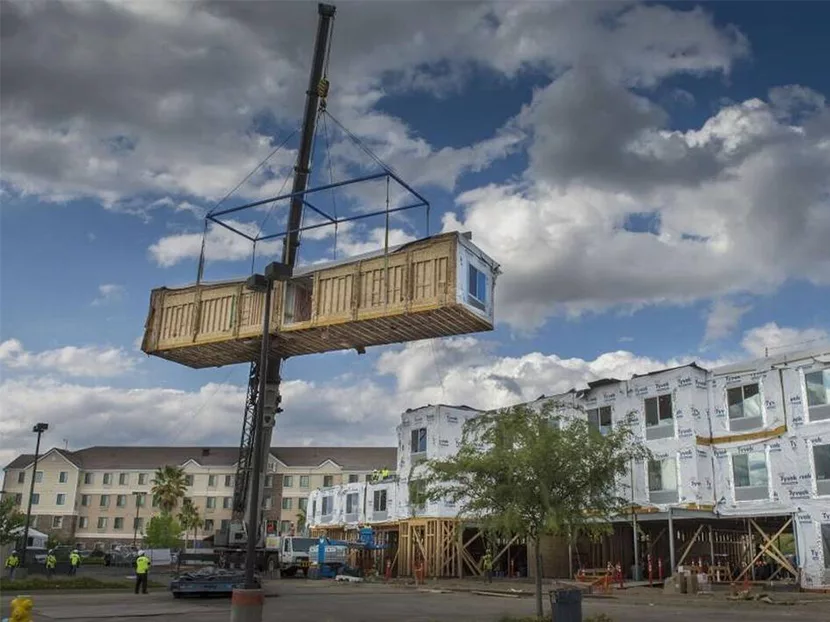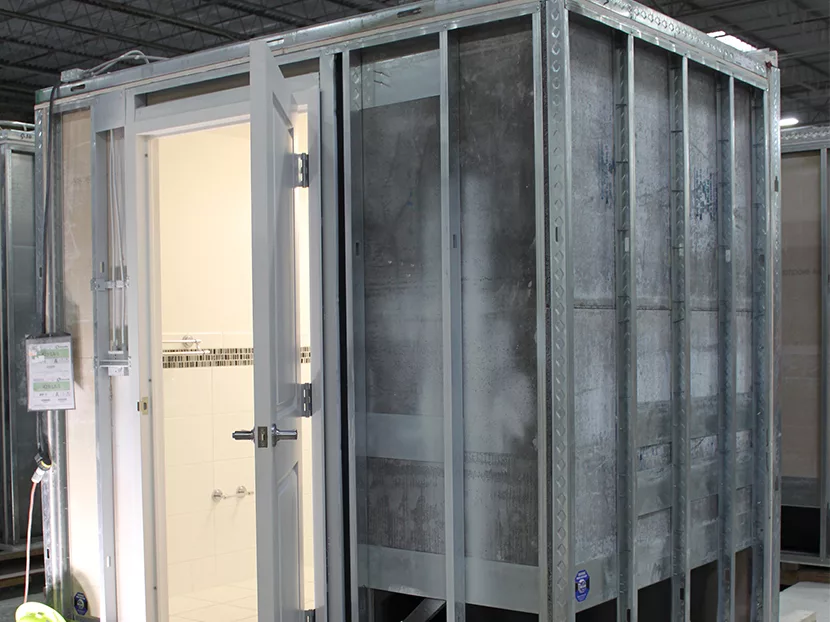Marriott International Inc., the world’s largest hotel company, unveiled a comprehensive expansion to its initiative to drive the adoption of prefabricated modular construction of its hotels in North America.
Last year, the company announced plans to sign 50 hotel deals within its Select Brand hotels, which include Courtyard by Marriott, Fairfield Inn & Suites, Aloft and Springhill Suites properties, that will incorporate prefabricated guestrooms and/or bathrooms. That would make up about 13 percent of signings for North America as of 2017.
"Construction is the next frontier for innovation, and modular is leading the way," says Eric Jacobs, Marriott International’s chief development officer of Select Brands, North America. "By working with our pre-approved modular partners, owners can open hotels faster, put associates to work earlier and generate revenue sooner."
Factory built
With the modular process, hotel guestrooms and bathrooms are manufactured away from the construction site in a climate-controlled factory.
The modular construction model is particularly well-suited to Marriott’s Select Brand, which includes generally standardized room layouts. Because the company doesn’t redesign the rooms every time it plans construction, modular companies can mass-produce the units simply by calculating the room’s square footage, amenities and bathroom requirements.
“From a staging perspective, our waste goes from 4 to 6 percent down to 2 or 3 percent,” Jacobs says. “The big takeaway from this process is that we can completely control the quality of the product.”
Think about it this way: would you buy a computer if you knew it was put together outside in the rain, sleet and sun?
Like most any other industrial assembly line, Marriott can identify quality issues right as the rooms come off the assembly line and find solutions before they ever get shipped to the site.
“It’s a pretty impactful way to produce a furnished building at the end of the day,” Jacobs adds.
Once made, the prefabricated units get transported to the hotel site. A crane slots the units into place in an efficient construction model called “stacking,” at which point workers complete the electrical, plumbing and other finishing work.
“As construction costs are at a peak, it’s a real challenge to find good, qualified subcontractors based on the general building boom that is happening throughout the United States,” Jacobs explains.
Some of those hotels have already been built. The Folsom Fairfield Inn & Suites in California was the first Marriott property built with a modular approach for hotel rooms. Opened for business on Dec. 1, the hotel was completed a full two months ahead of schedule.
About half of the first floor of the 97-room hotel, including employee rooms, pool, entryway and other guest amenities was built using traditional construction methods. The suites in the three-story hotel are made up of modules. According to Marriott, the installation of the modules took only four days.
Folsom’s modules were fabricated over a six-week period in the Boise, Idaho factory of Guerdon Modular Building while construction crews prepared the site by pouring the foundations and erecting stem walls.
Prior to shipping, the “FF&E,” hotel parlance for furniture, fixtures and equipment without any permanent connection to the building or utilities were installed in the factory. Guerdon produced units that contained two fully outfitted rooms, including bed, desk and toilet, plus a connecting corridor, that came complete right down to sheets and pillows in the closet and hi-def TV ready for viewing.
What is not physically installed was packed in the units and tied down for shipping. With the units fully furnished when the module arrives on site, crews spend less time in the suite and there is less interference of hotel staff training.
‘Heads to beds’
One month ahead of schedule sounds great for putting “heads to beds,” another bit of hotel vocabulary for “revenue” I discovered researching this feature.
However, Marriott sees even faster construction times in the future using a modular approach. According to the company, a traditionally built four-story Select Brand property takes about 12 to 14 months to complete. Modular construction could decrease that to 8 to 10 months, Jacobs says.
“If we can cut months off a typical development timeline,” Jacobs adds, “that’s a significant savings for our owners.”
Marriott on average has about 100,000 rooms a year in the pipeline, and the hope is that it can get to a point where half of those rooms are built in a modular fashion one day.
Last year, Marriott completed four other hotels under this initiative, including a Courtyard in Pullman, Washington, and three AC Hotels in Oklahoma City, Louisville and Chapel Hill, North Carolina.
“The reason Marriott and others are embracing the modular construction process is that it can dramatically shorten the overall construction schedule, which leads to quicker occupancy and quicker return on investment,” says Tom Hardiman, executive director of the Modular Building Institute.
Overall, about 3 percent of all construction starts use modular construction in North America, according to Hardiman. The percentage is historically lower in the hotel construction sector, but he expects that to change now that Marriott is embracing the concept.
“We feel that 5-6 percent is not unrealistic over the next few years,” he adds.
Started three years ago
Marriott’s modular initiative started more than three years ago when Karim Khalifa, senior vice president for global design, began looking at modular developments that are common throughout Asia and Europe.
After a rigorous selection process in North America to identify companies that could potentially manufacture hotel spaces, Marriott then launched a pilot modular initiative at its 2015 CONNECT conference.
Last year’s CONNECT conference featured a special outdoor exhibit in downtown Los Angeles of actual prefabricated rooms by its approved modular partners.
- A Courtyard guestroom produced by Guerdon.
- A SpringHill Suites guestroom produced by Champion Commercial Structures.
- An AC Hotels, Courtyard and Residence Inn bathroom module, produced by Oldcastle SurePods
In the meantime, the company has worked with owners who were early adopters of modular construction for their projects, as well as educating lenders about financing such projects.
“Our franchisees are really real estate entrepreneurs and this supports them being successful,” Khalifa adds. “We like it because it’s higher quality and a much more predictable outcome for us. We like to go into new places and find easy ways for our owners to get in at a quality level.”
To further monitor the initiative, Khalifa’s design team travels to each new site to collect data in real time and talk with developers about best practices and emerging opportunities.
Marriott also recently partnered with Seattle developers Stonebridge Companies, based in Englewood, Colorado, and Washington State University to allow students from the construction management and hospitality management schools to study the quality and the efficiency of the modular construction initiative. The Pullman, Washington Courtyard by Marriott is located on the campus of the university.
As an extra bonus, Marriott says modular construction has helped reduce noise between rooms, giving it an edge over its traditionally built rivals for a quieter night’s sleep.







